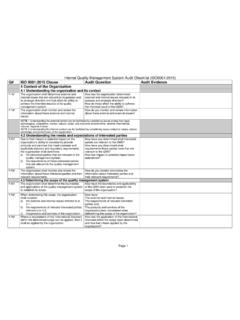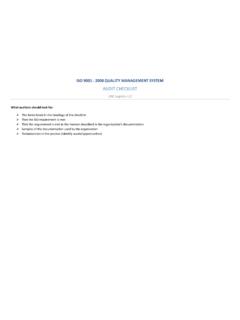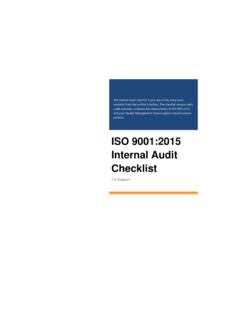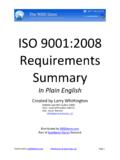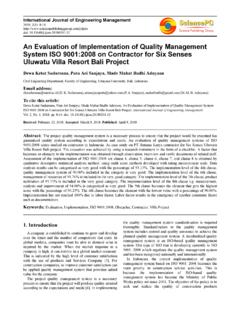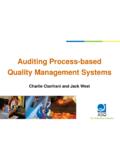Transcription of ISO 9001:2015 Gap Analysis Checklist - APB Consultant
1 iso 9001 : 2015 Quality Management Systems - The 2008 -to- 2015 Gap Analysis Checklist Page 1 of 64 1. PURPOSE The purpose of this document is to detail the gaps between the superseded standard iso 9001 : 2008 and the current standard iso 9001 : 2015 , to assist existing and potential clients assess their current Quality Management System and make the necessary changes to ensure that their systems as compliant. 2. DETAIL This gap Analysis Checklist is prepared for use in evaluating your Quality Management System (QMS) against the requirements of iso 9001 : 2015 as you transition from iso 9001 : 2008 to iso 9001 : 2015 .
2 Each requirement is expressed as a question that the user (auditor / assessor) can ask to evaluate your QMS capabilities. You will need to have copies of the iso 9001 : 2015 and iso 9001 : 2008 standards to use along with this Checklist so that you can refer to the requirements if necessary. While the two versions of the standard do not line up when comparing the requirements: New requirements and / or new terminology are highlighted in yellow. The intent of the main clauses of the new standard is shown in bold blue font.
3 The right hand column in green shade is intended to provide reference / comparison / similarities to the iso 9001 : 2008 requirements, and to identify and locate where in the new clauses, the former requirements are relevant. Comments highlighted in bold red font indicate removed / missing requirements. After you have prepared an audit schedule, and assigned responsibility to your auditors for different areas or processes to audit, copy each section of the Checklist for the auditors working with that section.
4 As you work through the Checklist take notes on what is in place, and what needs to be developed. In the space for currently in place , list or reference the procedures or other documents, or evidence that you have reviewed and that will provide information for the new QMS. Take notes on the status of the documents, that is, will they need to be revised for the new system, or can they be used as is? Also note where processes are in place, but documentation is needed. Focus on what is in place, and what needs to be developed.
5 While you do want to know if documented information is in place and if procedures and processes are being complied with, compliance is not your main focus for this audit. Remember that the final outcome of this audit should be a list of things that your company needs to do to comply with iso 9001 : 2015 . iso 9001 : 2015 Quality Management Systems - The 2008 -to- 2015 Gap Analysis Checklist Page 2 of 64 3. THINGS NOT TO DO While this Checklist does provide a comprehensive Checklist that covers the transition, the following needs to be noted.
6 Organization s do not need to: Remove their management representatives - While there is no requirement in ISO9001: 2015 for a management representative, this does not prevent organizations from choosing to retain this role if they so wish. Be aware, however, that some of the duties traditionally assigned to the management representative by top management will, in future, need to be undertaken directly by top management themselves. Throw out their Quality Manuals and Documented Procedures. While 9001: 2015 sets out no requirement for organizations to hold either a Quality Manual or Documented Procedures, if this documentation is in place, needed and working well, there is no need for it to be withdrawn.
7 Renumber existing QMS documentation to correspond to the new clause references - Although organizations may choose to carry out a renumbering exercise, it is down to each to determine whether the benefits gained from renumbering will exceed the effort involved in actioning the change. However, reference needs to be made to compliance with 9001: 2015 , if the organization wishes to demonstrate compliance to this standard. Restructure their management systems to follow the sequence of requirements as set out in the ISO9001: 2015 .
8 Providing all of the requirements contained in the Standard are met, the organizations system will be compliant. Refresh existing documentation to use the new terms and definitions contained within iso 9001 : 2015 . Once again, organizations are free to make the judgment as to whether this effort would be worthwhile. If organizations are more comfortable using their own terminology, records instead of documented information , or supplier rather than external provider then this is perfectly acceptable.
9 Page 3 of 64 iso 9001 : 2015 Quality Management Systems - The 2008 -to- 2015 Gap Analysis Checklist QUALITY MANAGEMENT SYSTEMS REQUIREMENTS Currently in Place Compliant YES / NO? If NO - % Complete Items Needed iso 9001 : 2008 Requirements 4 CONTEXT OF THE ORGANIZATION Quality management system This clause introduces two sub-clauses relating to the context of the organization, (1) understanding the organization and its context and (2) understanding the needs and expectations of interested parties.
10 Together they require that you determine the issues and requirements that can impact on the planning of the Quality Management System (QMS). In addition, the scope of the QMS and the QMS processes along with their applicability and interactions need to be determined. ---- Understanding the organization and its context ---- Does your company determine the external and internal issues that are relevant to your purpose and strategic direction? Do you consider the relevant issues that affect your ability to achieve the intended results of the Quality Management System (QMS)?

